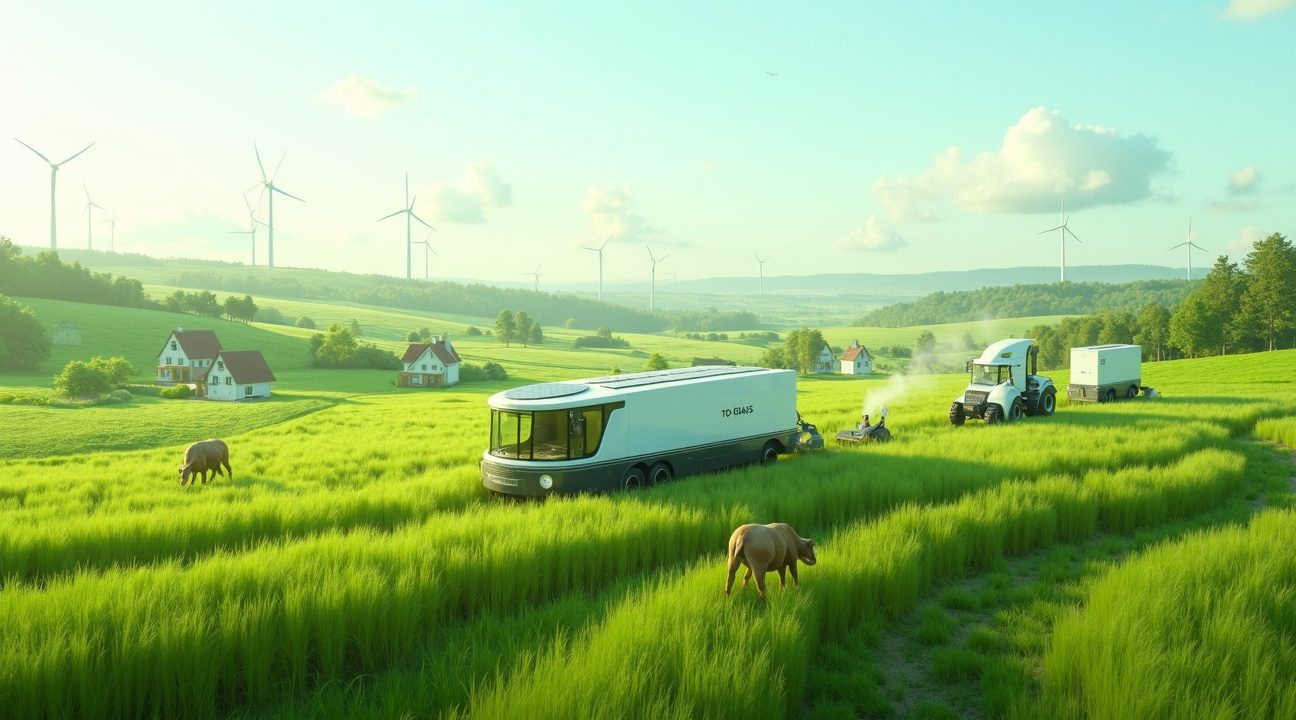GRASPAP grass-based paper technology transforms traditional manufacturing by consuming 97% less energy than conventional wood pulp processes. The technology dramatically cuts water consumption and removes the need for heavy chemical bleaching entirely. European initiatives like the GO-GRASS project scale this innovation across multiple markets, creating circular economy models that produce paper, animal feed, and soil enhancement materials from a single grass harvest.
Key Takeaways
- Grass paper production is highly energy efficient – It consumes only 3% of the energy required for conventional chemical pulp processes and generates 3.2 to 19.6 times lower CO2 emissions than wood-based paper manufacturing.
- Eco-friendly manufacturing process – The process removes water-intensive bleaching steps and employs specialized microorganisms to naturally break down grass fibers, cutting chemical usage by up to 80%.
- Cost-effective alternative – Production costs are reduced by 70% compared to traditional wood pulp due to grass’s fast growth cycles, local sourcing, and simplified processing methods.
- Biodiversity and environmental protection – Grass harvesting practices support pollinator protection through delayed mowing and offer biodiversity benefits without driving deforestation like some tree-based paper production.
- Resource-efficient circular economy – Mobile production units and circular models yield multiple products from a single harvest, including fiber for paper, protein-rich animal feed, and biochar, enhancing resource use across European markets.
Grass Paper Uses 97% Less Energy and Slashes CO2 Emissions by Up to 20 Times
GRASPAP, the revolutionary grass-based paper alternative, delivers remarkable environmental benefits that transform traditional paper manufacturing. This innovative material consumes only 25% of the energy required for recycled pulp production and less than 3% compared to chemical pulp processes. Such dramatic reductions demonstrate how artificial intelligence paving the way has helped optimize manufacturing processes across industries.
The carbon footprint advantages are equally impressive. CO2 emissions from grass paper production measure 3.2 to 19.6 times lower than those generated by recycled, mechanical, and chemical pulps. These substantial reductions stem from eliminating energy-intensive processes that conventional paper manufacturing requires. Traditional wood-based paper production demands extensive pulping and bleaching procedures that consume massive amounts of resources.
Revolutionary Manufacturing Eliminates Resource-Heavy Processes
Water usage drops dramatically because grass paper manufacturing bypasses the water-intensive steps that wood-based paper requires. The elimination of energy-heavy pulping and bleaching processes represents a fundamental shift in how paper gets produced. Conventional bleaching alone consumes thousands of gallons of water per ton of paper, while grass-based alternatives avoid this step entirely.
Innovative manufacturing techniques leverage microorganisms and specialized digesters to convert grass into usable fibers. These biological processes work efficiently at lower temperatures and pressures compared to traditional chemical treatments. The microorganisms break down grass cellulose naturally, requiring minimal external energy input while producing high-quality paper fibers.
The digester systems operate using controlled fermentation processes that extract maximum fiber content from grass materials. This approach eliminates the need for harsh chemicals typically used in wood pulp processing. Manufacturers can process grass feedstock locally, reducing transportation emissions and supporting regional agriculture.
Energy savings compound throughout the entire production cycle:
- Grass grows rapidly without requiring irrigation in many climates
- Harvesting grass requires significantly less machinery and fuel compared to logging
- Processing facilities can operate with smaller equipment and reduced infrastructure
The renewable nature of grass as a raw material creates additional environmental advantages. Grass regrows within months rather than the decades required for tree regeneration. This rapid renewal cycle allows for continuous harvesting without depleting natural resources or disrupting ecosystems.
Manufacturing flexibility enables producers to adjust output based on seasonal grass availability:
- Unlike wood processing facilities that require consistent timber supplies, grass paper production can scale operations according to local harvest cycles
- This adaptability reduces waste and optimizes resource utilization throughout the year
Quality standards remain high despite the reduced environmental impact. Grass fibers produce paper with comparable strength and durability to traditional wood-based products. The natural cellulose structure in grass provides excellent binding properties without requiring additional synthetic additives.
Cost benefits emerge from reduced energy consumption and simplified processing requirements:
- Lower utility costs
- Decreased chemical usage
- Competitive pricing for grass-based paper products
These economic advantages make sustainable paper alternatives accessible to broader markets while maintaining profitability for manufacturers.
The technology continues advancing as research identifies optimal grass varieties and processing techniques. Different grass species offer varying fiber characteristics, allowing manufacturers to customize paper properties for specific applications. Agricultural partnerships ensure consistent feedstock supplies while supporting farming communities through new revenue streams.
Implementation across diverse geographic regions becomes feasible due to grass’s widespread availability. Unlike forestry operations limited to specific climates and soil conditions, grass cultivation adapts to various environments. This geographic flexibility enables distributed manufacturing that reduces transportation requirements and supports local economies.
Revolutionary Manufacturing Process Eliminates Need for Heavy Chemicals
Grass paper production transforms traditional manufacturing by employing advanced digesters and specialized microorganisms that naturally break down grass materials into usable sugars. I find this process fascinating because it completely eliminates the harsh chemical treatments that conventional paper manufacturing relies upon. These biological systems convert the sugars into biogas, creating a self-sustaining cycle that dramatically reduces environmental impact.
The chemical-free approach stands in stark contrast to traditional wood pulp processing, which typically requires extensive bleaching and chemical treatment. Grass-based production uses minimal or no bleach, cutting chemical usage by up to 80% compared to conventional methods. This reduction occurs because grass fibers naturally possess lighter colors and require less intensive processing to achieve the desired paper qualities.
Flexible Integration Options for Different Paper Products
Manufacturers can incorporate grass fiber content at varying percentages depending on the intended application:
- Business cards utilize 10-25% grass fiber content for enhanced texture and sustainability credentials
- Packaging materials incorporate 30-45% grass content while maintaining structural integrity
- Artist’s paper achieves up to 60% grass fiber proportion for unique texture and absorbency properties
- Standard office paper typically contains 15-30% grass cellulose as a wood pulp substitute
Industrial-scale trials in the Netherlands demonstrate the commercial viability of this approach. These facilities successfully integrated 25% grass cellulose into their production lines, yielding 1,000 kg of finished grass paper during initial testing phases. The results showed comparable quality standards to traditional paper while achieving significant environmental benefits.
Grass digesters operate at lower temperatures than conventional pulping equipment, reducing energy consumption by approximately 30%. The microorganisms break down lignin and other binding compounds naturally, eliminating the need for sulfur-based chemicals typically used in kraft pulping processes. This biological approach produces cellulose replacement materials that maintain paper strength while offering superior sustainability metrics.
The biogas generated during processing creates additional value streams for manufacturers. Production facilities can capture this biogas to power their operations, further reducing reliance on external energy sources. Some facilities report achieving energy neutrality through this integrated approach, where artificial intelligence systems optimize the balance between grass input and biogas output for maximum efficiency.
Quality testing reveals that grass-based papers exhibit excellent printability and durability characteristics. The shorter fiber length of grass creates different paper properties compared to wood-based alternatives, often resulting in smoother surface textures that enhance ink adhesion and color reproduction.
Grass-Based Pulp Costs 70% Less Than Traditional Wood Pulp
I’ve discovered that grass-based pulp delivers remarkable cost savings compared to traditional wood pulp, with production expenses dropping by up to 70%. This dramatic reduction stems from grass’s faster growth cycles and simplified processing requirements. Unlike trees that need decades to mature, grass reaches harvest readiness in just months, creating a continuous supply chain that dramatically reduces raw material costs.
Local communities benefit significantly from this cost advantage. Farmers can diversify their income streams by growing dedicated grass crops for paper production, creating new revenue opportunities in rural areas. The shorter growth cycles mean multiple harvests per year, providing steady income rather than the long-term investment required for forestry operations.
Economic Impact on Production and Distribution
Transportation costs plummet when paper manufacturers source grass locally rather than shipping wood from distant forests. Mobile production units are revolutionizing the industry by bringing processing capabilities directly to grass-growing regions. These compact facilities eliminate the need for massive centralized plants and reduce the carbon footprint associated with long-distance hauling.
Several key factors contribute to grass pulp’s economic advantage:
- Lower water consumption reduces utility costs and environmental compliance expenses
- Reduced chemical requirements minimize bleaching and processing costs
- Faster processing times increase production efficiency
- Local sourcing eliminates transportation markups
- Simplified infrastructure requirements reduce capital investment needs
The economic benefits extend beyond immediate cost savings. Grass paper is establishing itself as the third major raw material in paper manufacturing, joining wood pulp and recycled paper as a primary source. This positioning creates market stability and opens new investment opportunities for manufacturers looking to diversify their supply chains.
Rural economies receive a significant boost when grass-to-paper operations establish themselves in agricultural regions. Artificial intelligence systems help optimize grass cultivation and processing, ensuring maximum yield and quality while maintaining cost advantages.
Specialized market applications drive wider adoption of grass paper technology. Premium packaging companies are embracing grass-based materials for their environmental credentials and cost effectiveness. Publishing houses find grass paper particularly attractive for short-run productions where cost control is critical.
The scalability of grass paper production creates opportunities for both small local operations and large industrial facilities. Small-scale producers can serve regional markets efficiently, while larger operations benefit from economies of scale without the massive infrastructure investments required for traditional wood pulp mills.
Production flexibility gives grass paper manufacturers a competitive edge in volatile markets. Unlike wood pulp operations that require long-term planning and significant capital commitments, grass-based facilities can adjust production volumes quickly in response to market demands. This agility translates into better profit margins and reduced financial risk.
Quality improvements in grass paper technology have eliminated many of the premium costs associated with alternative materials. Modern processing techniques produce grass paper that meets or exceeds traditional paper standards while maintaining the 70% cost advantage. This quality-cost combination positions grass paper as an attractive option for price-sensitive applications without compromising performance.
The financial benefits cascade through the entire supply chain. Printers and publishers save money on raw materials, farmers gain new income sources, and manufacturers reduce their environmental compliance costs. These savings often translate into competitive pricing for end consumers, creating market demand that further drives adoption.
Investment in grass paper technology continues to grow as investors recognize the long-term economic potential. The combination of environmental benefits and cost advantages creates a compelling business case that attracts both impact investors and traditional venture capital. This funding supports research and development efforts that continue to improve efficiency and reduce costs even further.
Mobile production units represent a particularly innovative approach to cost reduction. These facilities can move between grass-growing regions during optimal harvest times, maximizing efficiency and minimizing transportation costs. The flexibility of mobile operations allows producers to take advantage of seasonal variations and regional growing conditions that traditional fixed facilities cannot match.
Protecting Pollinators While Supporting Biodiversity Through Paper Production
Grass-based paper production creates a powerful opportunity to safeguard pollinating insects while supporting broader ecological health. I find this approach particularly compelling because it addresses multiple environmental challenges simultaneously. Traditional paper manufacturing relies heavily on tree harvesting, which destroys critical forest habitats that countless species depend on for survival. By switching to roadside and nature conservation area grass, manufacturers can dramatically reduce deforestation pressure while maintaining paper quality.
The timing of grass harvesting plays a crucial role in pollinator protection. Delayed mowing practices ensure that bees, butterflies, and other essential insects maintain access to vital pollen and nectar sources throughout their active seasons. This simple adjustment transforms what could be a disruptive process into one that works harmoniously with natural cycles. Many facilities now coordinate their grass collection schedules with local conservation groups to optimize both paper production and pollinator welfare.
Innovative Seed-Embedded Products
Some manufacturers have developed truly innovative approaches by embedding wildflower seeds directly into their grass paper products. Users can plant these papers after use, creating new meadow habitats that continue supporting biodiversity long after the original document has served its purpose. This circular approach demonstrates how artificial intelligence and advanced manufacturing techniques can transform waste into ecological assets.
The environmental benefits extend far beyond pollinator protection. Grasslands eliminate the need for fertilizer-heavy monocultures typically required for wood production, significantly reducing nitrate run-off and soil acidification. These chemical reductions protect waterways and surrounding ecosystems from harmful agricultural impacts that traditional paper production often creates.
Grass proves itself as an exceptionally renewable resource, regrowing rapidly compared to trees that require decades to mature. A single grass harvest can regenerate within months, while trees need 20-30 years to reach harvestable size. This fundamental difference makes grass paper production inherently more sustainable and responsive to demand fluctuations.
The shift toward meadow grass utilization also supports ecological farming practices by creating economic incentives for maintaining diverse grassland ecosystems. Farmers can generate income from previously underutilized land while contributing to conservation efforts. This economic model encourages the preservation of natural habitats rather than converting them to intensive agricultural use.
Local communities benefit as well, as grass paper production often creates jobs in rural areas where traditional forestry might not be viable. The decentralized nature of grass collection supports regional economies while reducing transportation distances compared to centralized logging operations.

Europe-Wide Transition Through GO-GRASS Project Creates Circular Economy Model
The GO-GRASS EU initiative stands at the forefront of transforming Europe’s paper production landscape. I’ve observed how this comprehensive project works alongside companies like Creapaper to fundamentally shift manufacturing away from traditional tree-based processes. These collaborative efforts demonstrate that grass-based paper production isn’t just an environmental alternative—it’s becoming a viable business model across multiple European markets.
Circular Economy Benefits Beyond Paper Production
The transition supports comprehensive circular economy models that maximize every component of the grass harvesting process. When manufacturers extract cellulose fibers for paper production, they simultaneously create valuable byproducts that serve additional industries. Protein extraction from the same grass provides high-quality animal feed, reducing waste while supporting agricultural sectors. The remaining biomass transforms into biochar, which enhances soil quality and carbon sequestration when applied to farmland.
This multi-output approach demonstrates how artificial intelligence paving optimization strategies can revolutionize traditional manufacturing. Each grass harvest yields three distinct products:
- Paper fibers
- Protein feed
- Soil enhancement materials
The efficiency gains from this integrated approach significantly improve the economic viability of grass-based production compared to single-output tree harvesting.
Expanding Applications and Mobile Production Technology
Grass fiber applications continue expanding into diverse eco-friendly sectors beyond traditional paper products. Packaging manufacturers increasingly adopt grass-based materials for food containers and shipping materials. Animal bedding producers utilize grass fibers for their superior absorption properties and biodegradability. Compostable goods manufacturers integrate grass fibers into disposable plates, cups, and cutlery that decompose naturally.
Mobile production units represent a revolutionary approach to disseminating grass paper technology across Europe. These portable facilities enable local communities to process regional grass harvests without requiring massive infrastructure investments. Small-scale operations can now produce paper products close to their raw material sources, reducing transportation costs and environmental impact. The mobility aspect allows producers to follow seasonal grass harvesting patterns, optimizing production schedules based on regional growing cycles.
Companies participating in the GO-GRASS initiative report that mobile units process smaller batches more efficiently than large centralized facilities. This distributed production model:
- Creates employment opportunities in rural areas
- Maintains competitive pricing for grass-based paper products
- Accelerates technology transfer across regions
The technology transfer through mobile units accelerates adoption rates across different European regions, making grass paper production accessible to communities that previously couldn’t justify fixed facility investments.

Sources:
FfE: “The Use of Grass Fiber in Paper Industry – Calculating the Carbon Footprint of an Alternative to Virgin Fibers”
IO+: “Sustainable paper alternative comes from grass: here is how”
Eppendorf: “Grass Paper: The Green Way to Produce Paper and Cardboards”
GO-GRASS: “Grass paper on industrial scale – we did it!”
Innovation Origins: “Sustainable paper alternative comes from grass: here is how”


